These resolutions on this page are fits to gaussian distributions at 0.7, 1,4, 3.0, 50.0 and
10 GeV, 1000 muons each. The sigma values are systematically smaller than RMS values, which are in turn smaller than
profile widths. Here is an example showing the values for the nominal case (no tilt, no stagger,
3mm panel thickness, 20% momentum smearing).
files in /phenix/workarea/hubert/cvs2/wrk:
fvtx_mc_eval_default.root
fvtx_mc_eval_0stagger.root
fvtx_mc_eval_1stagger.root
fvtx_mc_eval_-1stagger.root
fvtx_mc_eval_15mm.root
fvtx_mc_eval_30mm.root
fvtx_mc_eval_45mm.root
fvtx_mc_eval_50um.root
fvtx_mc_eval_75um.root
fvtx_mc_eval_100um.root
fvtx_mc_eval_20percp.root
fvtx_mc_eval_perfp.root
fvtx_mc_eval_5050100p.root
fvtx_mc_eval_tilt0000.root
fvtx_mc_eval_tilt0p0m.root
fvtx_mc_eval_tilt0pm0.root
fvtx_mc_eval_stagger-1_tilt0p0m.root
| 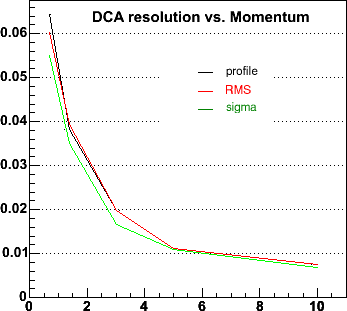
|
| DCA resolution vs momentum using barrel hits or not using barrel hits.
Change _use_vtx_hits in FindTrackMCPar.h, and rebuilt fvtxoo AND fvtx_subsysreco
| 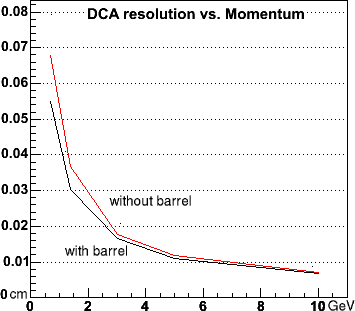
|
| Phi resolution vs momentum using barrel hits or not using barrel hits.
Change _use_vtx_hits in FindTrackMCPar.h, and rebuilt fvtxoo AND fvtx_subsysreco
In the plots that follow, the barrel hits are alway used.
| 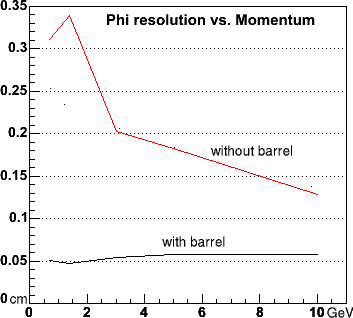
|
| DCA resolution vs momentum for support panel thicknesses of 0 to 11 mm.
Change panthk in
phnx.par
ErrorsFromProfile1.C (black)
ErrorsFromProfile2.C (red)
ErrorsFromProfile3.C (green)
| 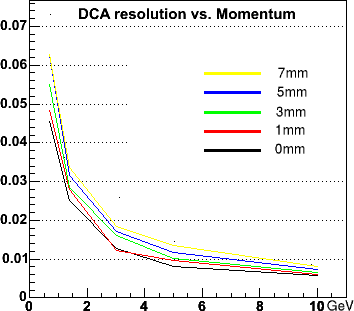
|
| Clearly, the dependence is weak. Taking a cut at 5 GeV, here is the resolution vs thickness:
In the model, carbon-carbon is represented by carbon at a reduced density, with
a radiation length of 23.9cm (instead of 18.8 from the PDG). The silicon
is 300μm thick, and the track angle is taken at the mean of 22°.
The current value, at ~1.6% is indicated by the green bar, corresponding to 101μm resolution.
10% worse resolution corresponds to 112μm, or 4.94 mm carbon thickness, or 2.58% R.L. (green
lines).
The current Hytec area-averaged thickness is 1.84% R.L., Increasing the area-averaged
thickness to 2.74% R.L would worsen the resolution by 10% (brown marks and text).
Source: http://pvd.chm.bnl.gov/twiki/bin/view/VTX/Presentations/ ->
HPS-111006-0006EPFVTXWedgeDesignStatus.ppt slide 8.
| 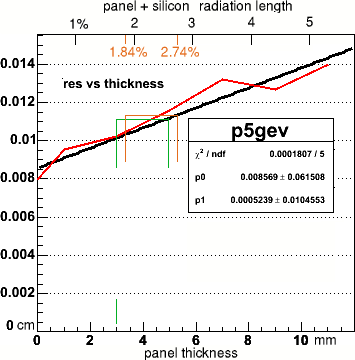
|
| DCA resolution vs momentum for different levels of knowledge about the track's momentum.
if the momentum is known to 20% (nominal,black), if the momentum is exact, and if the
momentum is not known at all, in which case it is set to a high value (50,50,100 GeV).
Modify code in fvtxoo/modules/mFvtxFindTrackMC.cxx:
// Initial momentum should be set to something non-perfect here,
// (1) I just set constant value, with appropriate pz sign for arm.
PHVector p_vector(50.0, 50.0, 100.0);
// (2) Or, for perfect momentum:
p_vector.setX(mc_trk_ptr->get()->get_px_orig());
p_vector.setY(mc_trk_ptr->get()->get_py_orig());
p_vector.setZ(mc_trk_ptr->get()->get_pz_orig());
// (3) or, put 20% error on true MC vector and store this. (default)
p_vector.setX(mc_trk_ptr->get()->get_px_orig() +
gsl_ran_gaussian(_rng, 0.2)*mc_trk_ptr->get()->get_px_orig());
p_vector.setY(mc_trk_ptr->get()->get_py_orig() +
gsl_ran_gaussian(_rng, 0.2)*mc_trk_ptr->get()->get_py_orig());
p_vector.setZ(mc_trk_ptr->get()->get_pz_orig() +
gsl_ran_gaussian(_rng, 0.2)*mc_trk_ptr->get()->get_pz_orig());
//cout<<" *** p = p +- 20% ***"<<endl;
// (3) or, put 20% error on true MC vector and store this. (default)
p_vector.setX(mc_trk_ptr->get()->get_px_orig() +
gsl_ran_gaussian(_rng, 0.2)*mc_trk_ptr->get()->get_px_orig());
p_vector.setY(mc_trk_ptr->get()->get_py_orig() +
gsl_ran_gaussian(_rng, 0.2)*mc_trk_ptr->get()->get_py_orig());
p_vector.setZ(mc_trk_ptr->get()->get_pz_orig() +
gsl_ran_gaussian(_rng, 0.2)*mc_trk_ptr->get()->get_pz_orig());
//cout<<" *** p = p +- 20% ***"<<endl;
| 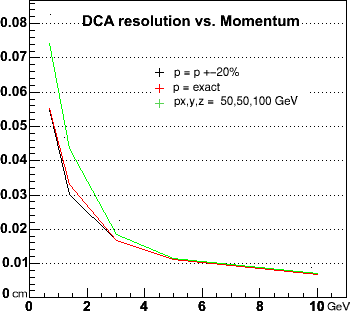
|
| DCA resolution vs momentum for different silicon strip widths. 75 μm (black, nominal),
50 μm (red), 100 μm (green).
Modify strip_width in
fvtxgeom.dat (near the bottom)
| 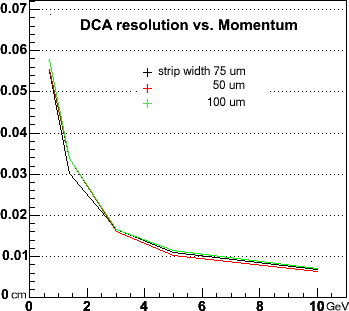
|
| Phi resolution vs momentum for different silicon strip widths. 75 μm (black, nominal),
50 μm (red), 100 μm (green).
Modify strip_width in
fvtxgeom.dat (near the bottom)
The crossing red and green lines are due to statistics. The sigmas are from
fits to
distributions that are not quite gaussian, giving rise to some scatter.
| 
|
| DCA resolution vs momentum for strips not tilted (black, nominal), and tilted by
11° (red) (0,+11°,0,-11° for stations 1-4, respectively), 0+-0 (green),
0-+0 (dark blue), -+-+ (yellow), +-+- (magenta)
Tilting the strips does not affect the resolution in the r-z plane.
Modify strip_tilt in
fvtxgeom.dat (at the bottom)
| 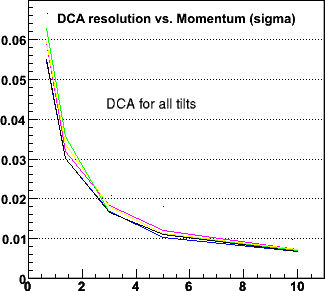
|
| Phi resolution vs momentum for strips not tilted (black, nominal), and tilted by
11° (red) (0,+11°,0,-11° for stations 1-4, respectively), 0+-0 (green),
0-+0 (dark blue), -+-+ (yellow), +-+- (magenta) .
Clearly tilting all 4 planes gives the best results.
Modify strip_tilt in
fvtxgeom.dat (at the bottom)
phires1.C (black)
phires2.C (red)
phires3.C (green)
| 
|
| DCA resolution vs momentum for strips not staggered (black, default), and staggered
by 1/4 of the strip length per plane.
Modify parameter stagger in
phnx.par
| 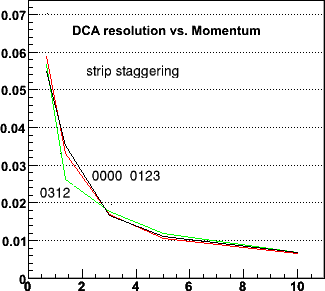
|
| Phi resolution vs momentum for strips not staggered (black, default), and staggered
by 1/4 of the strip length per plane.
Modify parameter stagger in
phnx.par
| 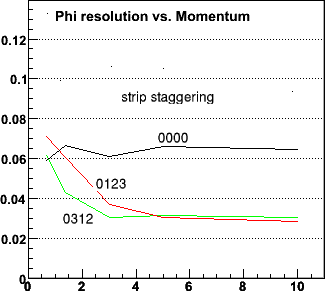
|
Phi resolution vs momentum for e few combinations of staggering and tilting.
S=0312 meand staggered planes, T=-+-+ is 4 planes with tilted strips, and T+S means both this
tilt and stagger. The effects do not combine multiplicatively. Just tilting the strips appears
to give the best results.
Modify parameter stagger in
phnx.par
| 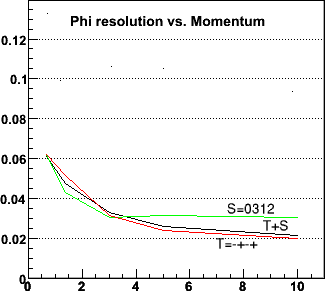
|
| DCA resolution vs momentum for various combinations of tilting and staggering strips.
Modify parameter stagger in
phnx.par
Modify strip_tilt in
fvtxgeom.dat
| 
|
| Phi resolution vs momentum for various combinations of tilting and staggering strips.
It appears that combination c, with no strip tilting would be the best. This is a bit surprising.
Modify parameter stagger in
phnx.par
Modify strip_tilt in
fvtxgeom.dat
| 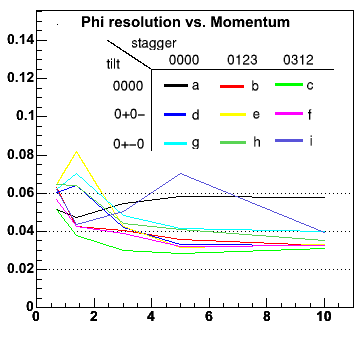
|














